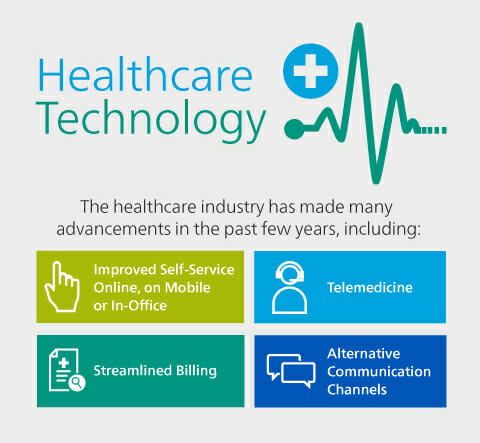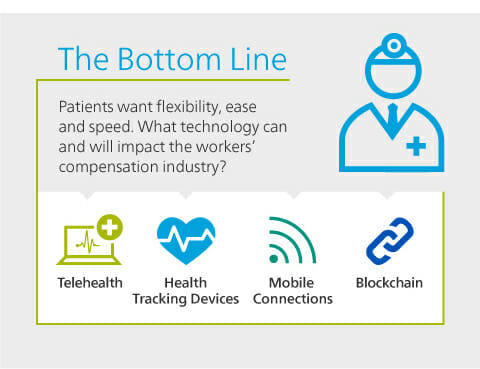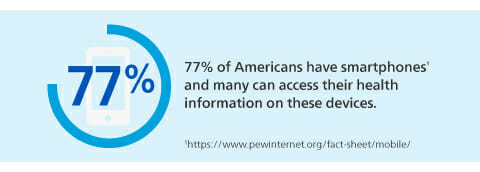Changing Consumer Expectations: What Workers' Compensation Can Learn from the Healthcare Industry
Learning from Technology Advances in the Healthcare Industry
What can workers’ compensation stakeholders learn from other industries in the age of automation and technology? In this article, we will explore how advances in the general healthcare industry and healthcare technology might influence changes in the workers’ compensation space. As technology develops even faster, consumer needs and expectations continue to change. For instance, the iPhone was launched just a little over a decade ago in 2007 and we have seen continuous iterations on the technology, driven in large part by the consumer. Many industries are seeing the effects of technology on their practices and working to adapt to these changes, implementing more technological capabilities and flexible communication channels into their everyday practices. The healthcare and workers’ compensation industries are no different. The people we serve have unique needs throughout their recovery, but the changing technological landscape still affects their perception of products, services and experiences.
Changes in Healthcare Provide Insight into What Consumers Want
The healthcare industry has made many advancements in recent years, particularly in the intersection of technology and customer service. Some examples include:
- Improved Self-Service: Patients can manage appoints or medical history online, on their smartphones and even at office check-ins.
- Streamlined Billing: Patients can view the current status of insurance processing.
- Telemedicine: Eliminates the need to even step foot in a doctor’s office.
- Alternative Communication Channels: Examples include text or email, and can replace phone calls or even office visits.
This shift to increased transparency and better user experience can likely be attributed to consumer demand. Most consumers today are deeply immersed in evolving technology and know the advantages of nearly immediate answers and flexible communication channels. The Bottom Line: Patients want flexibility, ease and speed when interacting with their healthcare providers. Patients in workers’ compensation have the same exposure to general technology changes as well as changes in healthcare, which means they share those expectations for fast, easy and reliable service. Therefore, when caring for injured workers, how can and should we leverage technology to aid in their recovery? Let’s take a closer look at opportunities.
How the Workers’ Compensation Industry Can Evolve with Changing Consumer Expectations
As consumers continue to change with an increasingly technological world, the workers’ compensation industry has opportunities to innovate. Some examples that we are seeing already in the industry include:
- Telehealth: Similar to the healthcare industry, workers’ compensation patients are able to connect with their doctors remotely, which is an advantage for rural patients in particular. (Learn how video chat is enabling new interactions in the claims process.)
- Health Tracking Devices: Workers and employers can use these devices to prevent incidents or improve recovery. (Read more on how wearable devices are changing workers’ compensation.)
These technologies did not necessarily originate in the workers’ compensation industry but have been adapted to the needs of injured workers and show promise for improving their recovery. Where else might we see technology advancements in the workers’ compensation industry?
Think Mobile First, Think Digital Second
Consumers use their cell phones consistently and they have come to rely on interacting with brands, including healthcare brands, online. Seventy-seven percent of Americans have smartphones and one in five only access the Internet through that device. Therefore, it is more important than ever that our interactions and communications reflect consumer reality and expectation. Last year, the American Academy of Family Physicians found that 69 percent of members have a web portal for communications and 12 percent offer direct text messaging with patients.
How would that look in the insurance world? PC360 answered some of those questions with their 2017 article on text messaging. As of 2018, Americans send 94 text messages per day, so the need for the workers’ compensation industry to embrace evolving communication channels continues to accelerate.
Blockchain
Blockchain is a major area that could be leveraged to improve the consumer experience. (Click here for a quick primer on blockchain). Blockchain has the potential to provide greater visibility, security and collaboration from multiple parties, including insurance companies, medical providers and pharmacies. For example, medical records or bills could be quickly verified without divulging unnecessary personal medical information. This is critical, as there currently is no one universal system for patient records (EHRs) and many entities do not have access to, nor do they need, all information in order to provide care or services. Blockchain could solve this problem by ‘connecting the dots’ and would ultimately lead to a safer, more seamless experience for the patient. It also could have an added benefit for those working on the claim to better understand risk factors and support them on their path to recovery.
How Your Organization Can Adapt to Changing Consumer Expectations
1. Understand the changing needs of your customers.
The needs, goals and behaviors related to care in workers’ compensation do not exactly align to those in the general healthcare environment, but the exposure of patients to evolving technologies is similar. How can your business adapt to these changes and provide your patients with better care?
2. Evaluate if you are offering flexibility, ease and convenience to your patients.
Consider what technologies can improve their experience while also making your business processes easier. Make sure you are choosing solutions that make the most sense for your business while providing safe, seamless and appropriate benefits to your patients.
3. Consider whether your business partners are aiding you in offering better solutions to your patients.
What plans are they putting in place for future changes? What technologies are they employing so you can better focus on your injured workers?
4. Understand how those in the healthcare industry implemented major technology changes.
In an industry that manages sensitive data, it is important to be careful with new technologies. The healthcare industry has managed to successfully implement several new technologies and the workers’ compensation industry can use these examples to work on advancements.
5. Work to integrate relevant technology to improve the overall customer experience as well as business processes.
Conclusion
The world is quickly changing; new technologies come into existence rapidly and consumer expectations are shifting with these advancements. Understanding how certain technologies can improve customer experience is important to providing the best care possible to the injured workers we serve. The healthcare industry, though not the same as the workers’ compensation industry, can provide good examples of how technology can be leveraged in a medical space. As we move forward in an increasingly technological world, we will be able to improve experiences and outcomes for our patients, but only if we are prepared to adapt.




